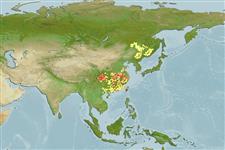Classification / Names
Common names from other countries
Main reference
Size / Weight / Age
Max length : 105 cm TL male/unsexed; (Ref. 40637); common length : 18.0 cm SL male/unsexed; (Ref. 35840); max. published weight: 50.0 kg (Ref. 30578)
Length at first maturity
Lm 51.7 range ? - ? cm
Environment
Freshwater; benthopelagic; potamodromous (Ref. 51243); depth range 0 - 20 m (Ref. 6898)
Climate / Range
Subtropical; 6°C - 28°C (Ref. 37797), preferred ?; 64°N - 43°S
Distribution
Asia: Native to most major Pacific dainages of East Asia from Amur to Xi Jiang, China (Ref. 59043). China and Eastern Siberia. Introduced around the world for aquaculture and control of algal blooms. Several countries report adverse ecological impact after introduction (Ref. 1739). Often confused with Hypophthalmichthys nobilis (Ref. 59043).
Countries | FAO areas | Ecosystems | Occurrences | Introductions
Short description
Dorsal
spines
(total): 1 - 3;
Dorsal
soft rays
(total): 6-7;
Anal
spines: 1-3;
Anal
soft rays: 10 - 14. Body olivaceous to silvery. Barbels absent. Keels extend from isthmus to anus. Edge of last simple dorsal ray not serrated. Branched anal rays 12-13.5 (Ref. 13274). Differs from Hypophthalmichthys nobilis by having sharp scaleless keel from pectoral region to anal origin, 650-820 long, slender gill rakers, head length 24-29% SL, and plain pale coloration, greenish grey above, whitish below (Ref. 59043).
IUCN Red List Status (Ref. 115185)
Threat to humans
Potential pest
Human uses
Fisheries: commercial; aquaculture: commercial
Tools
Special reports
Download XML
Internet sources
Estimates of some properties based on models
Phylogenetic diversity index
PD50 = 0.6250 many relatives (e.g. carps) 0.5 - 2.0 few relatives (e.g. lungfishes)
Trophic Level
2.0 ±0.00 se; Based on food items.
Resilience
Medium, minimum population doubling time 1.4 - 4.4 years (K=0.16-0.29; tm=2-6)
Vulnerability
High vulnerability (55 of 100)
Price category
